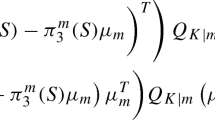Abstract
The purpose of this paper is to illustrate the potential use of discriminant analysis for discrete variables whose dependence structure is assumed to follow, or can be approximated by, a tree-structured graphical model. This is done by comparing its empirical performance, using estimated error rates for real and simulated data, with the well-known Naive Bayes classification rule and with linear logistic regression, both of which do not consider any interaction between variables, and with models that consider interactions like a decomposable and the saturated model. The results show that discriminant analysis based on tree-structured graphical models, a simple nonlinear method including only some of the pairwise interactions between variables, is competitive with, and sometimes superior to, other methods which assume no interactions, and has the advantage over more complex decomposable models of finding the graph structure in a fast way and exact form.





Similar content being viewed by others
References
Abreu GCG, Edwards D, Labouriau R (2010) High-dimensional graphical model search with the gRapHD R package. J Stat Softw 37(1):1–18
Asparoukhov OK, Krzanowski WJ (2001) A comparison of discriminant procedures for binary variables. Comput Stat Data Anal 38:139–160
Cheng J, Li T, Levina E, Zhu J (2017) High-dimensional mixed graphical models. J Comput Graph Stat 26(2):367–378
Chow CK, Liu CN (1966) An approach to structure adaptation in pattern recognition. IEEE Trans Syst Sci Cybern 2:73–80
Chow CK, Liu CN (1968) Approximating discrete probability distributions with dependence trees. IEEE Trans Inf Theory 14:462–467
Chow CK, Wagner TJ (1973) Consistency of an estimate of tree-dependent probability distributions. IEEE Trans Inf Theory 19:369–371
Edwards D, Abreu G, Labouriau R (2010) Selecting high-dimensional mixed graphical models using minimal AIC or BIC forests. BMC Bioinform 11:18
Friedman N, Geiger D, Goldszmidt M (1997) Bayesian network classifiers. Mach Learn 29:131–163
Goldstein M, Dillon WR (1978) Discrete discriminant analysis. Wiley, New York
Gou J, Levina E, Michailidis G, Zhu L (2015) Graphical models for ordinal data. J Comput Graph Stat 24(1):183–204
Hand DJ (1981) Discrimination and classification. Wiley, Chichester
Hastie T, Tibshirani R, Wainwright M (2015) Statistical learning with sparsity. CRC Press, Boca Raton, The lasso and generalizations
Højsgaard S (2012) Graphical independence networks with the gRain package for R. J Stat Softw 46(10):1–26
Højsgaard S, Lauritzen SL, Edwards D (2012) Graphical models with R. Springer, New York
Kim J (2009) Estimating classification error rate: repeated cross-validation, repeated hold-out and bootstrap. Comput Stat Data Anal 53:3735–3745
Krzanowski WJ, Marriott FHC (1995) Multivariate analysis Part 2: classification, covariance, structures and repeated measurements. Arnold, London
Kruskal JB (1956) On the shortest spanning subtree of a graph and the traveling salesman problem. Proc Am Math Soc 7:48–50
Lauritzen SL (1996) Graphical models. Oxford University Press, New York
Lee JD, Hastie TJ (2015) Learning the structure of mixed graphical models. J Comput Graph Stat 24(1):230–253
Loh PL, Wainwright MJ (2013) Structure estimation for discrete graphical models: generalized covariance matrices and their inverses. Ann Stat 41:3022–3049
Perez-de-la-Cruz G, Eslava-Gomez G (2016) Discriminant analysis with Gaussian graphical tree models. AStA Adv Stat Anal 100:161–187
Prim RC (1957) Shortest connection networks and some generalizations. Bell Syst Tech J 36:1389–1401
R Core Team (2013) R: a language and environment for statistical computing. R Foundation for Statistical Computing, Vienna, Austria http://www.R-project.org/
Tan VYF, Sanghavi S, Fisher JW, Willsky AS (2010) Learning graphical models for hypothesis testing and classification. IEEE Trans Signal Proces 58:5481–5495
Welch BL (1939) Note on discriminant functions. Biometrika 31:218–220
Acknowledgements
This work was written while GEG was at the Department of Applied Mathematics and Computer Science, Technical University of Denmark, on Sabbatical leave from the Faculty of Sciences at the National Autonomous University of Mexico (UNAM), and gratefully acknowledges a six months grant from the program PASPA, DGAPA, UNAM. GPC was a postdoctoral researcher at the Department of Applied Mathematics and Computer Science, Technical University of Denmark, and received a postdoctoral Grant (252737) by the National Council of Science and Technology (CONACYT) of Mexico. We are very grateful to Drs. H. Avila Rosas and L. D. Sánchez Velázquez for providing the ICU data, and for helpful discussions concerning the codification and selection of variables.
Author information
Authors and Affiliations
Corresponding author
Additional information
Publisher's Note
Springer Nature remains neutral with regard to jurisdictional claims in published maps and institutional affiliations.
Rights and permissions
About this article
Cite this article
Perez-de-la-Cruz, G., Eslava-Gomez, G. Discriminant analysis for discrete variables derived from a tree-structured graphical model. Adv Data Anal Classif 13, 855–876 (2019). https://doi.org/10.1007/s11634-019-00352-z
Received:
Revised:
Accepted:
Published:
Issue Date:
DOI: https://doi.org/10.1007/s11634-019-00352-z
Keywords
- Discrete variables
- Discriminant analysis
- Error rates
- Minimum weight spanning tree
- Multinomial distribution
- Sparseness
- Structure estimation
- Tree-structured graphical models




